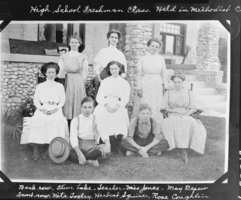Search the Special Collections and Archives Portal
Search Results

Transcript of interview with Paul Huffey and Michael Mack by Claytee White, February 2, 2010
Date
Archival Collection
Description
Whenever Paul Huffey drives through John S. Park Neighborhood he visualizes his youth and the times he spent with his childhood friend Michael Mack, who joined in this interview. Together they reminisced about their teen years in the 1950s and living in John S. Park Neighborhood. Paul's first home was Normandie Court, the first authentic motel in Las Vegas. In 1947, Paul's father purchased a lot on Paseo Park and built a home for his wife and only child. He describes life in that home as idyllic: no war or unemployment issues, a time when the Strip was "meaningless" unless you had a parent working there. An era when mothers, at least in his neighborhood, were stay-at-home moms and children freely roamed on their bicycles. Of their teen years, Paul and Michael recall their hi-jinks, discovering beer, and admiring pretty girls. In 1956, he graduated from Las Vegas High School, enlisted in the U. S. Army Reserve and enrolled in University of Nevada Reno. He taught history at Basic High School in Henderson for nine years.
Text

Patricia Lappin interview, February 26, 1980: transcript
Date
Archival Collection
Description
From the Ralph Roske Oral History Project on Early Las Vegas collection OH-01063. On February 26, 1980, Nancy Bright interviewed school teacher, Patricia Lappin (born April 14th, 1924 in Denver, Colorado) at Robert L. Taylor Elementary School in Henderson, Nevada. The interview covers Boulder City, Nevada around Hoover Dam. The two discuss the different gambling habits between Southern Nevada locals and Las Vegas tourists. During the latter half of the interview, the two speak at length about the impact of nuclear waste on Nevada. Lappin explains the unique issues that Southern Nevada faces as one of three states to accept nuclear waste.
Text
Audio recording clip of interview with Vicki Richardson by Claytee D. White, August 19, 2003, and January 29, 2004
Date
Archival Collection
Description
Part of an interview with Vicki Richardson conducted by Claytee D. White in two sessions on August 19, 2003 and January 29, 2004. Richardson describes the development of her art gallery as a community resource.
Sound
Kay Dwyer oral history interview
Identifier
Abstract
Oral history interview with Kay Dwyer conducted by Claytee D. White on August 16, 2000 for the Boyer Early Las Vegas Oral History Project. Dwyer discusses moving to Henderson, Nevada in 1942 when her father was hired by Basic Magnesium, Incorporated. She also discusses attending the University of Nevada, Las Vegas, formerly named Nevada Southern University, and having a career as a high school teacher in Las Vegas, Nevada.
Archival Collection
Timothy Harney oral history interview
Identifier
Abstract
Oral history interview with Timothy Harney conducted by Sherrae Chesmore on February 26, 2006 for the Public School Principalship Oral History project. In his interview Harney discusses his experiences as public school teacher and principal in Southern Nevada. He also talks about what a typical day for a principal is like and what the expectation of teachers and principals are.
Archival Collection
Aldeane Ries oral history interview
Identifier
Abstract
Oral history interview with Aldeane Ries conducted by Jennifer Meskimen on April 21, 2002 for the Public School Principalship Oral History Project. In this interview, Ries reflects upon her nearly 40-year career as a teacher and administrator with Nevada’s Clark County School District. She discusses the process by which she became an administrator, her approach to school administration, and her regular job responsibilities as principal. She describes changes within the school district over her 40-year career, cultural diversity among students and staff, and the importance of maintaining relationships with parents and students. She also offers suggestions for individuals interested in pursuing school administration.
Archival Collection

Film transparency of a high school freshman class, Las Vegas, 1912-1913
Date
Archival Collection
Description
Image
Howard Wasden oral history interview
Identifier
Abstract
Oral history interview with Howard Wasden conducted by Gillian Collins on an unknown date in the 1970s for the Ralph Roske Oral History Project on Early Las Vegas. In this interview, Wasden discusses arriving in Las Vegas, Nevada in 1925 and working for the railroad. Wasden explains how the railroad was a predominant economic asset for Las Vegas at the time. He then describes living on the Westside "Old Town", education in Las Vegas, attending the University of Nevada, Reno, and eventually becoming a teacher. Lastly, Wasden discusses the population growth, development of the Las Vegas Strip, and his role as principal of West Charleston School.
Archival Collection

Transcript of interview with Dr. Fiona Kelley by Lisa Gioia-Acres, March 21, 2009
Date
Archival Collection
Description
Dr. Fiona Kelley was born and raised in Connecticut. Her parents were both teachers (though her mother quit teaching to raise their two daughters), and Fiona recalls the European vacations the family took every summer, exploring castles and enjoying picnic lunches. Fiona was educated at Greenwich Academy in Connecticut and Bard College (dance major with art history minor) in New York. She mentions dancing in Acapulco and California and then auditioning and being hired as a cover dancer for Hallelujah Hollywood! at the MGM in Las Vegas. Meanwhile, she had also become licensed in massage and states that as she was making the transition from dancing to production of dance, she and her husband were invited to China. While in China, Dr. Kelley recalls visiting a hospital which specialized in the treatment of AIDS through acupuncture. This led to a decision to learn Oriental medicine, which she pursued once she returned to the United States. She shares many details of her studies
Text
